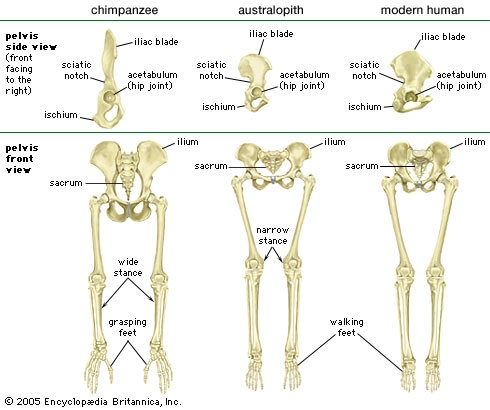pelvic girdle
anatomy
also called bony pelvis
in human anatomy, basin-shaped complex of bones that connects the trunk and legs, supports and balances the trunk, and contains and supports the intestines, urinary bladder, and internal sex organs. The pelvic girdle consists of paired hipbones, connected in front at the pubic symphysis and behind by the sacrum; each is made up of three bones—the blade-shaped ilium, above and to either side, which accounts for the width of the hips; the ischium, behind and below, on which the weight falls in sitting; and the pubis, in front. All three unite in early adulthood at a triangular suture in the acetabulum, the cup-shaped socket that forms the hip joint with the head of the femur (thighbone). The ring made by the pelvic girdle functions as the birth canal in females. The pelvis provides attachment for muscles that balance and support the trunk and move the legs, hips, and trunk. In the infant the pelvis is narrow and nonsupportive. As the child begins walking, the pelvis broadens and tilts, the sacrum descends deeper into its articulation with the ilia, and the lumbar curve develops.
 In the semierect (evolution) apes (ape), the centre of gravity falls near the shoulder, and the abdominal organs depend from the vertebral column. The ilium is elongated and somewhat spoon-shaped, and the pelvis is oriented horizontally. When a human being is standing erect, the centre of gravity falls over the centre of the body, and the weight is transmitted via the pelvis from the backbone to the thighbone, knee, and foot. Morphological differences from apes include the following: the ilium is broadened backward in a fan shape, developing a deep sciatic notch posteriorly; a strut of bone, the arcuate eminence, has developed on the ilium diagonal from the hip joint (concerned with lateral balance in upright posture); the anterior superior iliac spine, on the upper front edge of the iliac blade, is closer to the hip joint; and the ischium is shorter. The pelvis of Australopithecus africanus, which lived more than 2 million years ago, is clearly hominin. Homo erectus and all later fossil hominins, including Neanderthal man, had fully modern pelvises.
In the semierect (evolution) apes (ape), the centre of gravity falls near the shoulder, and the abdominal organs depend from the vertebral column. The ilium is elongated and somewhat spoon-shaped, and the pelvis is oriented horizontally. When a human being is standing erect, the centre of gravity falls over the centre of the body, and the weight is transmitted via the pelvis from the backbone to the thighbone, knee, and foot. Morphological differences from apes include the following: the ilium is broadened backward in a fan shape, developing a deep sciatic notch posteriorly; a strut of bone, the arcuate eminence, has developed on the ilium diagonal from the hip joint (concerned with lateral balance in upright posture); the anterior superior iliac spine, on the upper front edge of the iliac blade, is closer to the hip joint; and the ischium is shorter. The pelvis of Australopithecus africanus, which lived more than 2 million years ago, is clearly hominin. Homo erectus and all later fossil hominins, including Neanderthal man, had fully modern pelvises.Sex differences in the pelvis are marked and reflect the necessity in the female of providing an adequate birth canal for a large-headed fetus. In comparison with the male pelvis, the female basin is broader and shallower; the birth canal rounded and capacious; the sciatic notch wide and U-shaped; the pubic symphysis short, with the pubic bones forming a broad angle with each other; the sacrum short, broad, and only moderately curved; the coccyx movable; and the acetabula farther apart. These differences reach their adult proportions only at puberty. Wear patterns on the pubic symphyses may be used to estimate age at death in males and females.
- Tout, Thomas Frederick
- Tove Jansson
- Tovey, Sir Donald Francis
- Towada, Lake
- tower
- Tower Bridge
- Tower Hamlets
- Tower of Babel
- Tower of Hercules
- Tower of London
- Tower of the Winds
- towhee
- Towle, Katherine Amelia
- Towne, Laura Matilda
- Townes, Charles Hard
- town meeting
- Townsend family
- Townsend Harris
- Townsend, Sir John Sealy Edward
- Townshend Acts
- Townshend, Charles
- Townshend, Charles Townshend, 2nd Viscount
- township
- Townsville
- Towson